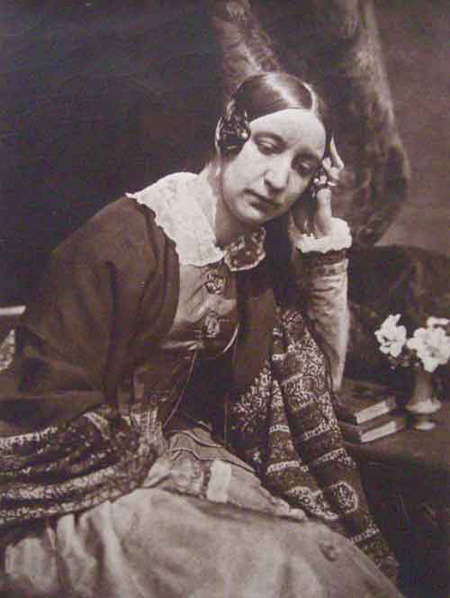1840 - 1860

Printer unidentified
Elizabeth Rigby
From a calotype by Hill and Adamson, circa 1847
Albumen print, date unknown
[Norfolk County Council Library and Information Service]
Hill and Adamson
David Hill and Robert Adamson were pioneering photographers, now acknowledged as masters of the art, working in Edinburgh, a city where they were not constrained by Henry Talbot’s English patent on his calotype process. They exploited their opportunity to the full, creating a magnificent series of photographic prints throughout their partnership (1843-1847). Their salted paper prints were made from calotypes [paper negatives] and have a soft, painterly appearance.
Elizabeth Rigby1 was one of 14 children of Dr. Edward Rigby, who lived in St. Giles, Norwich and had a country residence in Framingham Earl. The physician and one time Mayor of Norwich was additionally distinguished when Pitt Lane, which ran between St. Giles and Bethel Street, was re-named Rigby’s Court.
During the mid-1840s, when Elizabeth was in Edinburgh, she became one of the favourite sitters of Hill and Adamson who made 16 photographic portraits of her in different poses. In the collection of the Norfolk County Council Library and Information Service there is a portrait of her printed from a negative by Hill and Adamson. It is an albumen print that has a shiny, cracked surface printed sometime after 1851. The printer(s) is not identified and, indeed, Sara Stevenson writes2 that ‘… The albumen prints are not accounted for.’
In the 1840s Elizabeth met and married Charles Eastlake R.A. who, in 1850, was both knighted and elected President of the Royal Academy. In 1853 he was appointed first President of the Photographic Society of London and, in 1855, Director of the National Gallery. As Lady Elizabeth Eastlake she had many articles published in the Quarterly Review and in 1857 she anonymously contributed3 a 26 page review titled ‘Photography’. In this perceptive history of early photography, she also discussed the position of photography in art.
Sources and Notes
- Lochhead, Marion. Elizabeth Rigby. Lady Eastlake. London : John Murray, 1961.
- Stevenson, Sara. David Octavius Hill and Robert Adamson. Catalogue of their Calotypes taken between 1843 and 1847 in the Collection of the Scottish National Portrait Gallery. Edinburgh : National Galleries of Scotland, 1981.
- [Eastlake, Lady Elizabeth] published anonymously in Quarterly Review, (London) 101 (April 1857), pp. 442-68, titled ‘Photography’.